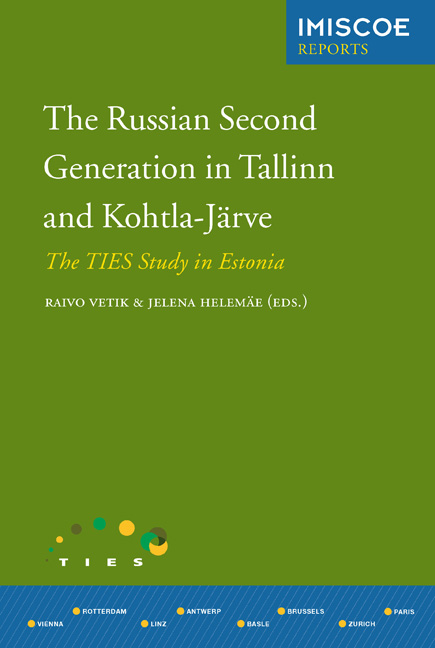Book contents
- Fronmatter
- Contents
- Preface
- List of Tables, Figures and Chapter Appendices
- 1 Introduction
- 2 Migration Patterns
- 3 Integration Policies
- 4 Ethnic Inequalities in Education
- 5 Explaining Different Returns from Human Capital in the labour Market
- 6 Income Inequality
- 7 Housing Conditions Andneighbourhood Satisfaction
- 8 Contact and Crisis in Interethnic Relations
- 9 Gender role Attitudes
- 10 Sense of Belonging to Estonia
- 11 Conclusions
- Appendix
- List of Contributors
- Other IMISCOE Titles
7 - Housing Conditions Andneighbourhood Satisfaction
Published online by Cambridge University Press: 20 January 2021
- Fronmatter
- Contents
- Preface
- List of Tables, Figures and Chapter Appendices
- 1 Introduction
- 2 Migration Patterns
- 3 Integration Policies
- 4 Ethnic Inequalities in Education
- 5 Explaining Different Returns from Human Capital in the labour Market
- 6 Income Inequality
- 7 Housing Conditions Andneighbourhood Satisfaction
- 8 Contact and Crisis in Interethnic Relations
- 9 Gender role Attitudes
- 10 Sense of Belonging to Estonia
- 11 Conclusions
- Appendix
- List of Contributors
- Other IMISCOE Titles
Summary
Introduction
Questions about distinct opportunities for accessible and affordable housing related to ethnic minority issues did not form part of the Estonian public policy discourse until after the fundamental societal transformation and reintroduction of capitalist relations towards the end of the last century. Likewise, residential and regional patterns of segregation, which are based on an ethnic rather than a socio-economic differentiation of inhabitants, were not formed recently but rather, are embedded in the specific socio-structural context of the previous Soviet socialist system. The legacy of these past societal developments is apparent and, thus, creates a unique socio-physical situation in urban residential contexts, as well as in the entire Estonian housing field. In European cities, research on minority ethnic groups has been focused on explaining the differences between native-born and minority ethnic groups in segregation patterns and housing conditions. Extensive research, which began in the United States in the 1920s and in Europe in the 1970s, has revealed the disadvantaged position of ethnic minorities in the field of housing. They have been found to occupy the worst segments of housing and residential areas, something reinforced by their insecure position on the labour market (see Özüekren & Van Kempen 2003). It has been documented that minority groups have greater difficulties in accessing social housing (e.g. in the Netherlands, France and Austria), as well as encountering the prejudice and discrimination of landlords or housing agencies in the private sector (ibid.: 163, 168; see also Teixeira & Murdie 1997). A lack of interethnic cultural knowledge and communication skills prevents immigrants from gaining an understanding of the local housing system. This, in turn, contributes to their low position in the housing field. The concentration of immigrants into poor residential areas is viewed as a restriction on the scope of individual participation (see Aalbers & Deurloo 2003) in other fields of the host society.
However, A. Sule Özüekren and Ronald van Kempen (2003) have stressed the complexity of ethnic segregation and integration processes in the housing field, particularly in relation to the actual diversity and dynamics of ethnic minority groups, as well as to the local and countryspecific structural differences between the host countries. Ethnic minorities form diverse groups with differentiated collective and individual capacities, which lead to distinct housing careers developing within the particular structural contexts.
- Type
- Chapter
- Information
- The Russian Second Generation in Tallinn and Kohtla-JärveThe TIES Study in Estonia, pp. 143 - 164Publisher: Amsterdam University PressPrint publication year: 2012



